15 Best Ab Rollout Alternatives (No Ab Wheel Needed!)
Ab Rollouts using an Ab Wheel are an excellent core exercise that teaches how to brace your core and builds core stability. Not only do they help develop core stability, but they also add some upper-body shoulder stability and strength as well.
However, sometimes you may find yourself needing an alternative for Ab Rollouts.
The most obvious reason would be that you don’t have access to an ab wheel. But, maybe you’re just looking to add some variety to your workouts.
Whatever the reason, if you’re looking for an exercise to substitute for Ab Rollouts then you’re in the right place. I’m about to share with you 15 of my favorite Plank alternatives.
Ab Rollout Alternatives
I tried to include as much variety within this list of Ab Rollout alternatives as possible. You’re going to find exercises that look very similar to Ab Rollouts, exercises that are done standing, on the floor and exercises that use different pieces of equipment.
What all these movements have in common though is that, like Ab Rollouts, they are all great for building core strength and stability. These exercises will also challenge most of the major core muscles, including the Rectus Abdominis and Obliquus Externus Abdominis.
My goal is that no matter what equipment you may access to or what your level of experience is, at least one of these Ab Rollout alternatives will be a perfect fit for you.
Ab Rollouts w/ Barbell
Did you know you can do Ab Rollouts with a barbell and bumper plates on each side?
If you’re looking for Ab Wheel alternatives that still allows you to do the same basic movement, a barbell and bumper plates are your best option.
Equipment Needed
- Barbell with Bumper Plates on each side
Muscles Worked
- Abdominal Core Muscles (Rectus Abdominis, Obliques Externus Abominis)
- Back (Latissimus Dorsi and Teres Major)
How To
- Place a 10kg or larger plate on both sides of the bar.
- Start on your knees with an overhand shoulder-width grip on the bar.
- Brace the core hard and begin rolling the bar forward.
- Roll out until you feel you’re about to fall and then begin pulling the bar back.
- Repeat until all reps are completed.
Coaching Points
Don’t allow your hips to stay behind you as you begin to roll forward. Hips should stay relatively in line with the knees and shoulders, similar to a Plank.
Stir The Pot
If you have access to a stability ball, Stir the Pot is one of the best Ab Rollout alternatives that is very similar but provides a very unique challenge to your abdominal muscles.
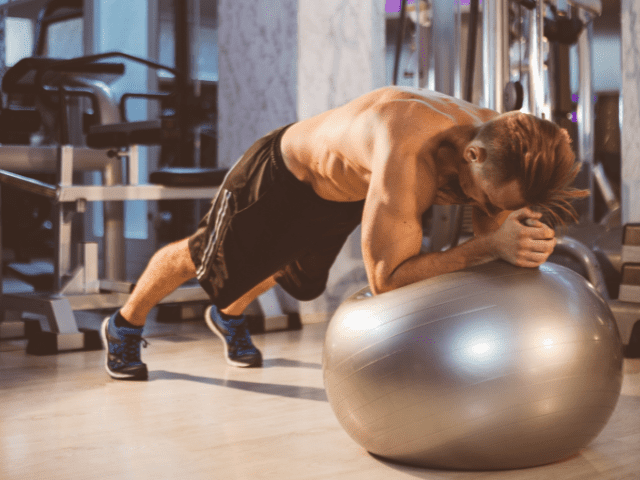
Equipment Needed
- Stability Ball (also sometimes called a Physio Ball or exercise ball)
Step-by-Step Instructions
- Start on your knees with the Stability Ball directly in front of you.
- Place your forearms on the ball and clasp your hands together.
- Now slowly lift up off of your knees, balancing yourself with your forearms on the ball and toes on the ground.
- You should now basically be in plank position, but with your forearms on a stability ball instead of the ground.
- Now work your hands into small circles. This should simulate, you guessed it, stirring a pot with a big wooden spoon.
- Work clockwise until all reps are completed and then switch and go counter-clockwise as well.
- Once all reps are completed lower back down to your knees.
Coaching Points
Take your time getting properly set up! If you’ve never done Stir the Pot before it can be surprising just how hard it is to balance yourself on a stability ball in this manner let alone shift in circles.
Hanging Leg Raises
Hanging ab exercises are a great way to really challenge the core and the upper body.
If you want an exercise that does more than just develop core strength, hanging ab exercises like Hanging Leg Raises are excellent Ab Rollout alternatives.

Equipment Needed
- Pull-Up Bar – Ideally a stand-alone pull-up bar or one connected to a squat rack although any sturdy object you can hang from will technically work.
Muscles Worked
- Abdominal Core Muscles (Rectus Femoris, Obliques Externus Abdominus)
- Quadriceps, Rectus Femoris
- Tensor Fasciae Latae (TFL)
- Back and Forearms
Step-by-Step Instructions
- Find yourself a pull-up bar and grip the bar with an overhand grip.
- Engage your lats so your body doesn’t go limp once you begin to hang.
- Now hang from the bar and keeping your legs straight, drive them up to hip height (or slightly above hip height).
- Finally, actively lower your legs back to the starting position – don’t allow the legs to just swing down.
- Repeat until all reps are completed.
Coaching Points
The biggest issue that most of my athletes run into when doing Hanging Straight Leg Raises (or any hanging ab exercise for that matter) is how to keep from swinging out of control.
To keep from swinging, you have to actively lower your legs back down. If you ‘let your legs go’ and just allow gravity to take over you’ll completely lose control of the movement. Timing and rhythm are also both important for Leg Raises and you can’t achieve either if you’re not in control of your legs throughout the movement.
Plank
Planks are a great option for building core strength and stability and, best of all, require no equipment at all.
So, if you don’t have an ab wheel or even a stability ball – don’t worry – there are still plenty of options to replace an ab wheel rollout.

Equipment Needed
- None
Step-by-Step Instructions
- Start on the ground on your stomach.
- Assume a push-up like position on your elbows and toes. Elbows should be directly under the shoulders.
- Position your body in a straight line from the shoulders through the hips, knees and ankles.
- Brace the core tight. (As if you’re going to be punched in the stomach)
- Do not let the body slouch to the ground nor push the hips up high in the air.
- Hold for the designated amount of time.
Coaching Points
The biggest mistake that I see with Front Planks is athletes holding the position, but not properly keeping the core engaged and just allowing the torso to slouch. So, while they are technically up on their elbows and toes, all they’re really doing is straining the low back.
The other mistake I see is the exact opposite and that is athletes shooting their butts into the air, resembling more of a Down Dog position.
The difference between the two is the second, having your butt too high, is easier to notice and corrected more often. However, letting the body slouch during a plank is often allowed to pass as ‘good form’ when it is not.
Plank Jacks
Love Planks, but want to add a little variety to them? Plank Jacks is a great option to add variety and new challenges to your plank sets.
And, just like with Planks, no Ab Wheel (or any equipment) needed.
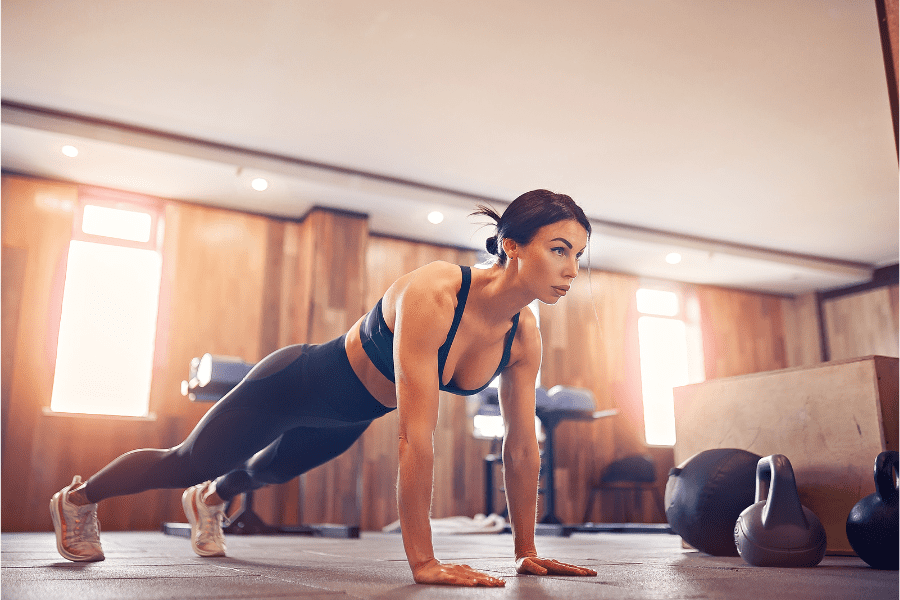
Equipment Needed
- None
Muscles Worked
- Core (Abdominals and Erector Spinae)
- Adductors and Abductors of the legs
- Shoulders (stabilizers)
How To
- Start in a plank position with your hands placed slightly wider than shoulder-width apart on the ground.
- Make sure your body is in a straight line from your head to your heels, and engage your core to keep your body stable.
- From this position, jump your feet out to the sides, landing with your feet slightly wider than shoulder-width apart.
- Without letting your hips sag or rise up, quickly jump your feet back together again.
- Continue jumping your feet out and in at a steady pace, keeping your core engaged and your body in a straight line until all reps are completed.
Coaching Points
If you need to modify the exercise, you can do plank jacks with your elbows on the ground (wrist injury for example). You can also step your feet out and in instead of jumping if you need to make the exercise a bit easier.
The most important thing to focus on is keeping your core braced and your body in a straight line throughout the movement. Don’t rush and get out of control and sloppy with your technique.
Plank Pull Throughs
Plank Pull Through is another plank variation that gets the upper body more involved similar to Ab Rollouts. Great exercise for both the core and the shoulders.
Equipment Needed
- Kettlebell or Dumbbell
How To
- Start on your stomach with a kettlebell sitting just to the right side of the body.
- Raise up into a push-up position – hands under the shoulders and body in a straight line.
- To begin, brace on the right arm and reach under the body with the left hand and grab the kettlebell.
- Pull the kettlebell through under the body to the opposite side.
- Now, brace on the left arm and reach under the body with the right hand and pull the kettlebell back.
- Continue alternating back and forth until all reps are complete.
Coaching Points
Keep the core braced as you pull the kettlebell from one side to the other. Try to not rotate and twist through the torso as you move the weight. Try to stay square and maintain core stability.
Bird Dogs
Bird Dogs are a more beginner-friendly alternative to Ab Rollouts that work many of the same muscle groups. If you don’t feel ready to take on rollouts yet, Bird Dogs may be a good option to start with.
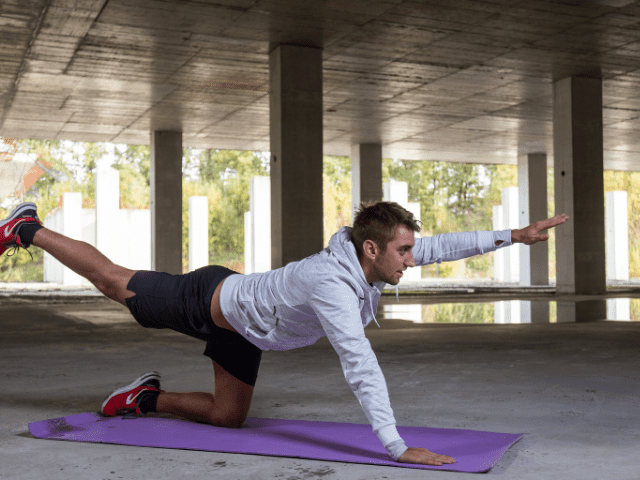
Equipment Needed
- None
Step-by-Step Instructions
- Start on the ground, on your hands and knees.
- Simultaneously lift one arm and the opposite leg. (ex. right arm and left leg)
- Lift the arm straight out in front of the body, palm down. It should finish parallel to (or slightly higher than) the torso.
- Lift the leg straight out below the body, squeezing the glute at the top. It should finish parallel to (or slightly higher than) the torso.
- There should now be a (relatively) straight line through the ankle, knee, hip, shoulder and hand.
- Reset back to the starting position and then repeat the movement on the other side.
- Continue to alternate back and forth until all reps are completed.
Coaching Points
Keep the eyes focused down with the head neutral throughout the movement. Do not try to look up as this will cause the back to overarch.
Dead Bug
Dead Bug is basically an upside-down Bird Dog which, to be honest, I had never really thought of them like that until writing this sentence. Dead Bugs, like Bird Dogs, combines movement with stability with more focus on the abs versus the low back.
Equipment Needed
- None
Muscles Worked
- Core Abdominals (Rectus Abdominis, Obliques Externus Abdominis)
- Tensor Fascae Latae (TFL)
- Quadriceps Rectus Femoris
How To
- Begin by lying on the floor on your back.
- Raise both arms straight up toward the sky.
- Bend both knees at a 90-degree and raise the legs until the knees are directly vertical of the hips.
- Tuck the hips and flatten the low back against the ground.
- Brace the core and simultaneously lower the right leg and left arm toward the floor.
- The arm should end up six inches from the ground directly overhead.
- The leg should end up six inches from the ground directly below the hip.
- Return both back to the starting position and then lower the opposite arm and leg.
- Continue alternating back and forth, pausing and ‘locking-in’ each rep.
Coaching Points
The back will naturally want to arch as you go through this movement. Try not to let it. Keep your hips rolled up and your low back flat against the ground.
Don’t rush through this exercise. Stay nice and slow and under control. Pause each rep at full extension before returning to the starting position.
Medicine Ball Slams
If you’re looking for a dynamic movement to train the core you can’t do much better than Med Ball Slams. Think of them as the power version of Ab Rollouts.
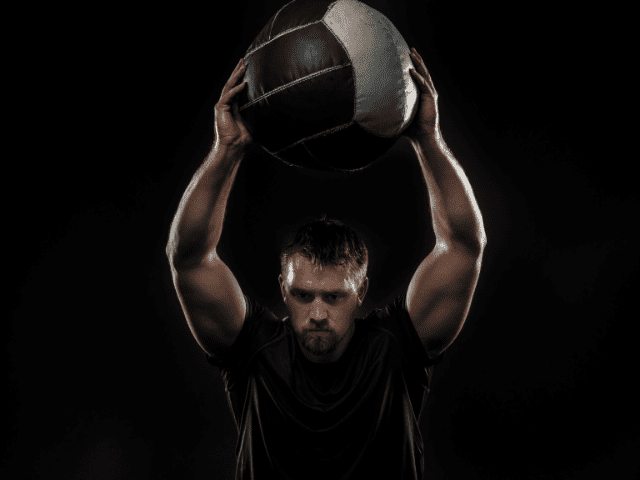
Equipment Needed
- Medicine Ball (it’s literally in the name)
Step-by-Step Instructions
- Grab a medicine ball and stand tall with feet roughly shoulder-width apart.
- Reach the medicine ball high overhead.
- Using the core, pull the body down – hinging forward at the hips.
- Follow through with the arms and release the ball.
- Let the ball slam into the ground, catch it off the bounce and repeat for the designated number of reps.
Coaching Points
First and foremost, test how ‘bouncy’ your medicine ball is before starting. I can’t tell you how many times I’ve seen athletes almost have their face smashed by a medicine ball bouncing much harder and rebounding much faster off the ground than they were anticipating.
The biggest mistake I see with Med Ball Slams is athletes not utilizing the core and simply throwing the ball down with their arms. The bulk of the force should be generated by aggressively using the core to hinge forward. If done correctly, it should almost (and actually might) lift your feet up off the floor.
Don’t have a medicine ball? Here are my favorite alternatives for Medicine Ball Slams.
Lateral Bridges
Want something to target the obliques? Lateral Bridges are a dynamic version of the Side Plank that also gets the glute med involved.

Equipment Needed
- None
Step-by-Step Instructions
- Start on the ground in a Lateral Plank position – on your side, one elbow down and feet, hips and shoulders stacked vertically above one another.
- The opposite hand (non-support arm) can be placed on the hip or held up in the air.
- From this position, lower the hips down and lightly tap the floor.
- Drive the hips back up to the starting position and repeat for the designated number of reps.
Coaching Points
The biggest mistake I see with my athletes with Lateral Bridges is allowing the top shoulder to hunch forward. Both shoulders (along with hips and feet) should be stacked directly above each other. Do not allow yourself to twist forward toward the ground with your upper body.
Single Arm Farmer’s Walk
Single Arm Farmer’s Walk is one of my favorite exercises for training core stability. This Ab Rollout alternative combines the bracing needed to improve core stability (like a plank) while moving. This forces the entire core to work in unison with the rest of the body.
Equipment Needed
- Dumbbell or Kettlebell
How To
- Grab a single kettlebell or dumbbell.
- Brace the core and begin walking in a slow, controlled manner.
- As you walk, focus on keeping the core braced and the shoulders and hips square and level.
- Once you cover the assigned distance (or time), switch hands and repeat on the opposite side.
Coaching Points
You do not need to grab the heaviest kettlebell you can find. Find a weight that you can walk with and maintain proper form.
Don’t rush through. Single Arm Farmer’s Walk can be done for time or for distance. If going for distance, it should not be a speed walk to cover the ground as fast as possible. Stay under control and focus on form.
Mountain Climber Crossovers
Mountain Climber Crossovers are an often underestimated core exercise that will not only work your core muscles but will also light your hip flexors on fire. Don’t sleep on this movement just because it reminds you of junior high gym class.
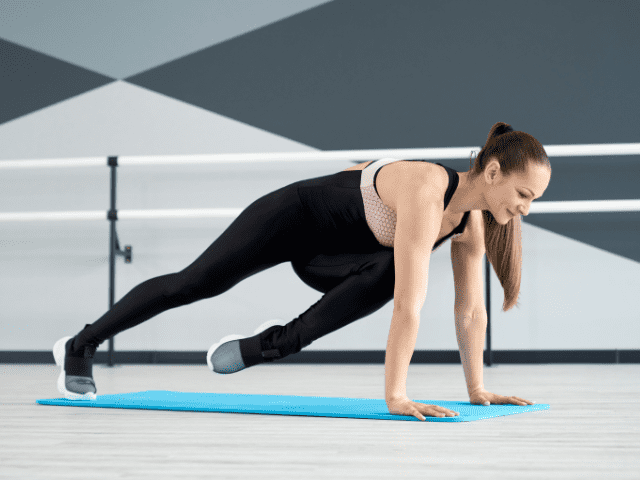
Equipment Needed
- None
How To
- Begin in a push-up position – hands under shoulders, core engaged, body in a straight line.
- Now drive the right knee across the body toward the opposite elbow.
- As you bring the right foot back to the starting position, begin to drive the left knee toward the opposite elbow.
- Continue alternating back and forth until all reps are completed. (count moving left and right legs up as one rep)
Coaching Points
Keep hips down throughout the movement. Don’t allow the hips to start to raise if you begin to tire. Also, work to maintain the same range of motion throughout the entire set of Mountain Climber Crossovers.
Seated Medicine Ball Twist
Medicine Ball Twists will challenge your ability to stabilize your core while using your oblique muscles to rotate from side to side. Out of all the Ab Rollout alternatives on this list, this might be the one movement I use the most in my programming.
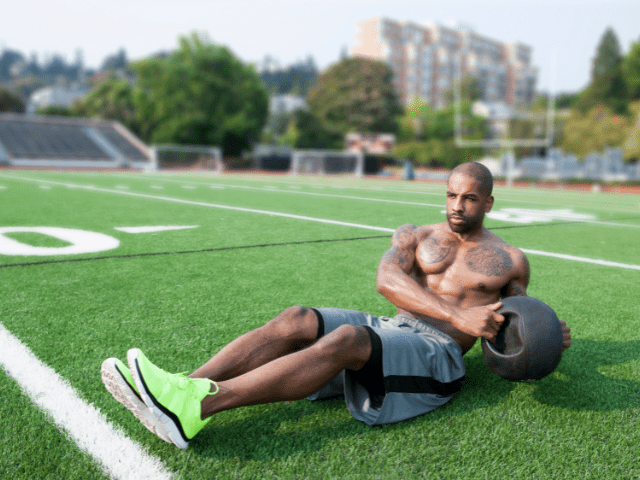
Equipment Needed
- Medicine Ball
Muscles Worked
- Obliques Externus Abdominis
- Rectus Abdominis
Step-by-Step Instructions
- Start by grabbing a medicine ball and taking a seat on the floor.
- Slightly bend the knees and raise your feet roughly six inches off the floor.
- Start by rotating your torso to the left and lightly tapping the med ball against the ground.
- Now turn your shoulders and rotate your torso to the right and, again, lightly tap the ball against the ground.
- Keep legs mostly still and maintain the feet off the floor throughout the movement.
- Continue rotating back and forth until all reps are completed.
Coaching Points (Common Mistakes)
The biggest mistake I see with my athletes when doing Seated Med Ball Twists is moving the ball back and forth primarily with their arms instead of rotating through the core. The focus should be on the rotation. The ball touching the ground is simply an added bonus to the movement.
Speaking of the ball touching the ground – there is no need to bang the ball off the ground as hard as possible each rep. Stay in control of the movement and the med ball and lightly tap it on the ground.
Supermans
Not the guy with an ‘S’ on his chest, the exercise. Supermans are a simple but effective low back exercise that doesn’t require any equipment.
Equipment Needed
- None
Step-by-Step Instructions
- Lay on your stomach with arms extended out overhead.
- Contract the low back and glutes and raise the chest, arms and legs (thighs) off the ground.
- Squeeze and hold for a one count and then lower back down to the ground.
- Repeat until all reps are completed.
Coaching Points
Take your time and don’t rush through the movement. Squeeze the top of each rep and lower yourself back to the ground under control. Too often I see athletes just quickly go through the motions with Supermans – focus on each rep to get the max benefit.
Straight Leg Sit Ups
The last suggestion on this list of Ab Rollout alternatives is Straight Leg Sit-ups.
Sit-ups may be boring, but there is a reason why they’ve been around so long. They don’t require any equipment and they’re extremely effective.
If you don’t have an ab wheel, you can always use a replacement like Straight Leg Sit-ups to work on your core strength.
Equipment Needed
- None
Step-by-Step Instructions
- Lay on your back, leaving your legs straight and flat on the ground.
- Place your hands either behind your head for support, besides the ears or arms crossed in front of the chest.
- Sit up by contracting and flexing the abdominals until your torso becomes perpendicular to the ground. (sitting straight up)
- Lower back down to the floor and repeat for the designated number of reps.
Coaching Points
The biggest mistake that I see with Straight Leg Sit-ups is essentially the same mistake that I see with regular Sit-ups. It is pulling way too hard on the back of the head. If you are going to place your hands behind your head, do so only to support the head, not pull on it.
Instead of placing the hands behind the head you can also keep hands by the ears, or in front of the chest if needed, but avoid pulling on the back of the head.

Online Strength Programs
- 1-on-1 Online Coaching
- Sports Performance Programs for Football, Basketball, Soccer & More
- Programs for Former Athletes (Legends) Who Still Want to Train Like Athletes
- Programs for Adults Who Want to Get Healthy (and look great at the beach!)
- Use Code “HB10” to Get 10% Off Today
Final Thoughts
Ab Rollouts with an Ab Wheel are an awesome exercise for developing strong core muscles and upper body strength, but sometimes they’re just not an option. Maybe you don’t have an Ab Wheel or maybe Ab Rollouts really bother your low back.
In these situations, you’ll need an Ab Rollout alternative and I hope that one of the exercises I’ve listed here fits what you were looking for.

